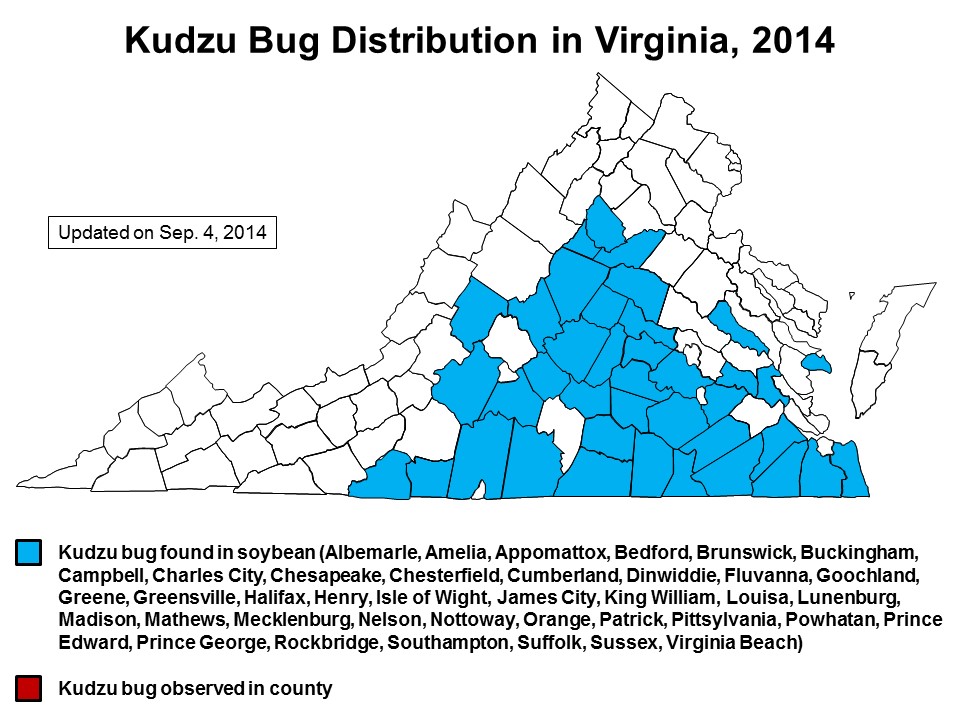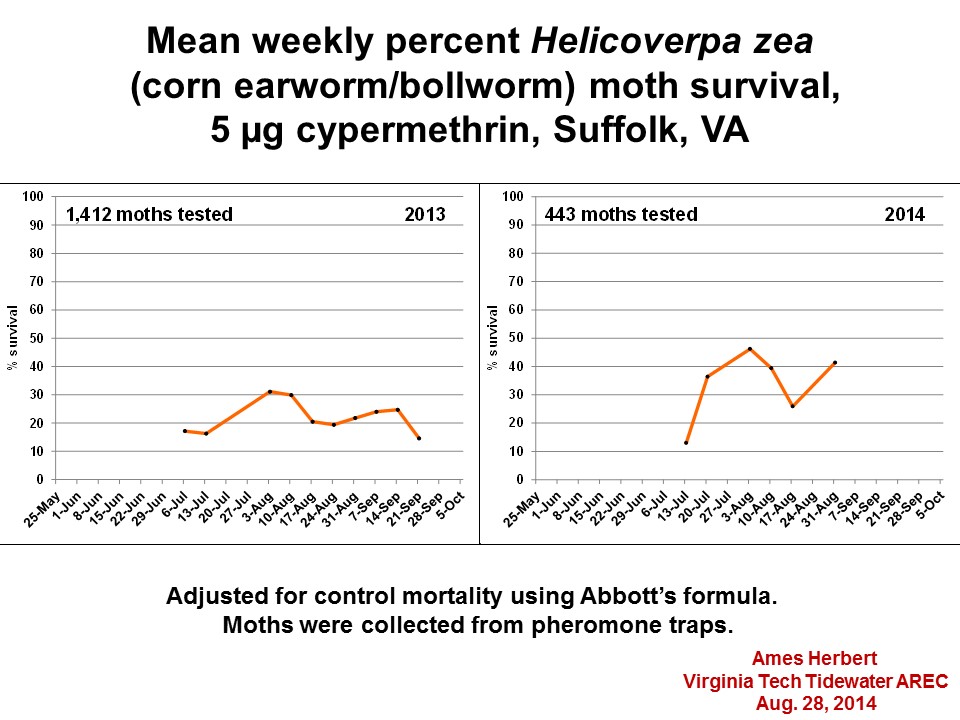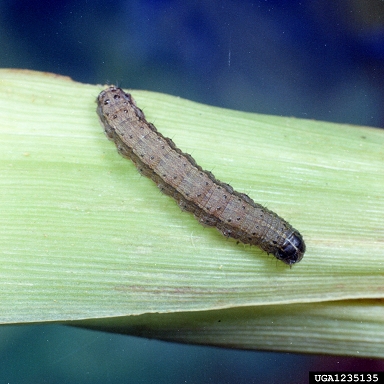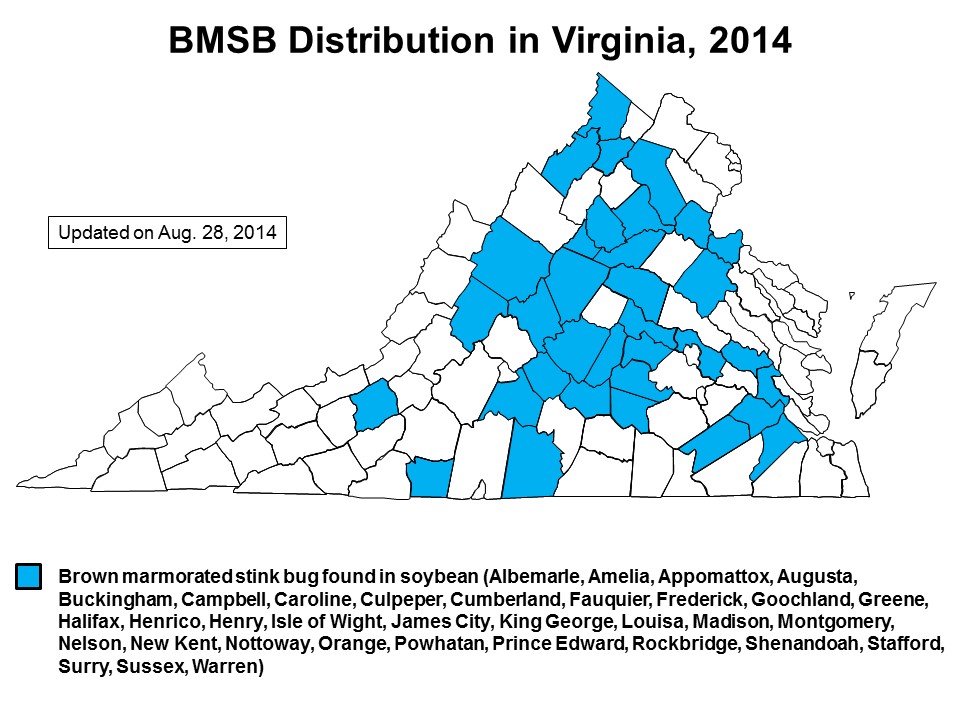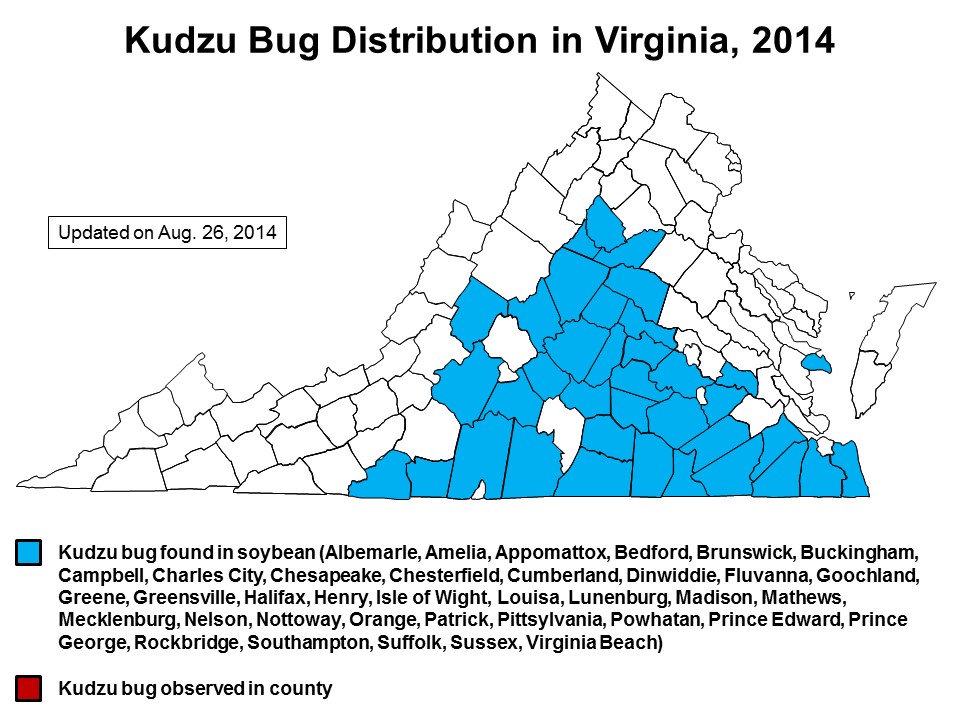Although numbers are still generally very low, our field scouts and others have found BMSB and kudzu bug in a few new counties this past week. The eight new counties added for BMSB are Gloucester, Charles City, Hanover, Spotsylvania, Rappahannock, Prince George, Suffolk and Chesapeake (thanks Stan Winslow for the Chesapeake report). The two new kudzu bug counties are James City and King William (thanks Paul Bodenstine for the King William report). See the maps below for the most recent distributions. Although there may have been a few fields treated for these pests, as far as I can determine most have not. We know of one grower in Campbell County who had some threshold numbers but only in a few patches along one field edge. He elected to spot treat only these patches and so far, our post treatment visits have shown that this strategy was successful, that is, no reinfestation and no spread.
Peanut Crop Update for Virginia
Maturity wise, seasonal heat units accumulated by peanut fields from May 1st to Sep 1st in Virginia are between 2252 to 2376 °F. Therefore, we started a weekly pod maturity determination by the pod mesocarp color of Williams and Drexler (1981). We grouped the pods on a maturity board into white, yellow, orange, brown, and black color groups. The profile maturity classes defines white and yellow as immature, and orange, brown and black as mature pods; orange is defined as incipient maturity, brown full maturity, and black over mature pods. We used Bailey planted on May 5th and May 20th, and CHAMPS planted on May 27. Both Bailey and CHAMPS mature in approximately 145 days after planting or 2600 heat units. Peanut maturity determined on Sep 2nd
Our data indicate that in Virginia all plantings have the majority of the pods, 75 % to 91%, in the yellow and orange color groups (yellow predominates) with more spread for early May plantings (12% were in the white and 13% the brown group) and more uniform pods for late May planting (only 9% were a combination of white and brown).
Appearance wise, peanut vines start showing drought symptoms due to current high temperatures and absence of rainfall in many fields in Virginia. As of now, we are looking at 30 to 40 days to optimum maturity but more delay is expected if no significant rainfall will be soon received and in absence of irrigation.

Late Blight Found in Floyd County
Late blight has been confirmed on tomato in Floyd County, VA, by the Virginia Tech Plant Disease Clinic. Potato and tomato growers should take precautionary actions and increase scouting. Cool and wet conditions favor development of this disease and fungicide sprays should be in place before the disease is present in a field or garden. For more information on late blight and late blight management, refer to the Extension publication available at: http://pubs.ext.vt.edu/ANR/ANR-6/ANR-6_pdf.pdf . Late blight was previously identified in Loudoun County, VA, on July 22; Rappahannock County, VA, on August 8; and Montgomery County, VA on August 20.

Fall armyworm moth counts are unusually high
For the past several years we have been using pheromone traps to monitor fall armyworm moth flights at the Tidewater Center. The numbers we have been catching these past few days are much higher than what we have normally seen. Fall armyworm has two strains. They are identical in appearance but one prefers to feed on grasses (the grass strain) and the other prefers to feed on legumes, cotton and other hosts. We cannot tell which strain we have by looking at the moths, but we do know that fall armyworms can infest peanuts, cotton, sorghum, turfgrass and many other crops. We have not found any fall armyworms in the peanut fields in the vicinity of the adult traps, but if they are going to occur, we would expect to see them next week. Moths have to mate, lay eggs on the peanut leaves, and worms hatch from the eggs—typically a 5 to 7 day cycle. In peanuts there would have to be a lot of worms to warrant a treatment. This late in the season, and with the extensive plant canopies that most peanut fields have, it would take at least 6 worms per row foot to trigger a spray. It has been many years since we encountered that many worms in a peanut field—but, we strongly suggest that you spot check fields for these critters.
Corn earworm update: few moths but with high tolerance to pyrethroids
Although we hear rumors of worms in soybean fields, our scouting does not confirm this. We are finding almost none in either full season or double crop fields—and others are reporting the same. The full season crop is quickly approaching the ‘safe’ zone, that is, the point where pods are too tough to be attractive to insect pests. But, the summer is not over yet. Because corn is slow to dry down this year, we may still see a corn earworm moth flight into soybean fields, and if this happens, double crop fields would be a primary target. This is also true for stink bugs. As we get into late summer and early fall, stink bugs will be attracted to double crop fields. We strongly recommend that you begin checking double crop fields.
Because of the very weak corn earworm moth flight, we have not been able to capture and test nearly as many moths for pyrethroid tolerance as we have in the past. But all indications are that levels are high (see the graph below). In the most recent sample more than 40% survived the vial challenge. If this high pyrethroid tolerance level coincided with a large flight the large numbers of worms in fields, we would no question be recommending non-pyrethroids. But with this weak flight and the low numbers of worms in fields, I think we can get decent enough control with high rates of pyrethroids, alone.
Reports of worm damage in NC cotton
We are getting reports of bollworm outbreaks and damage in cotton in areas of North Carolina, not far from the Virginia border. I know of no confirmed cases in Virginia, but fields should be checked over the next week or so. Although the corn earworm/bollworm moth flight has been extremely weak in Virginia, it may not be over. Corn is slow to dry down this year and may release another flush of moths. By now, a lot of bolls, the lower and first position bolls, are safe from worms—too tough for them to chew through. But there are still upper and outer position bolls that are soft and susceptible. We recommend scouting all fields, as we are hearing that the NC problem is occurring on several different varieties. 3% live worms or fresh worm damage is a good rule-of-thumb threshold.
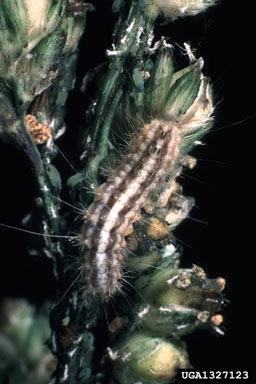
Worms in Sorghum
We received a sorghum head sample today from Dinwiddie County with sorghum webworm (see image on right). This is a known pest of sorghum and we have seen them before, but because of their smaller size compared to other head worm species, the threshold is an average of 5 per head across the field. To date, we have never seen nearly this many in any field, but this is a pest that should be scouted for. We are also seeing a very large number of fall armyworm moths in our pheromone traps here at the Tidewater Center. Fall armyworm is another sorghum head pest (see the image below), along with corn earworm, and the threshold for these species is an average of 2 per head. We recommend scouting sorghum fields until heads have hardened seeds. If fall armyworm is found in threshold numbers and a treatment is needed, pyrethroids will not do the job. The best results will be with non-pyrethroids like Belt, Prevathon or Besiege.
Brown marmorated stink bug (BMSB) and kudzu bug (KB) in more counties but numbers still very low
We are still finding BMSB and KB in new places—7 new counties for BMSB (Sussex, Albemarle, Cumberland, New Kent, King George, Isle of Wight, and Surry), and KB in 3 new counties (Mathews, Mecklenburg, and Virginia Beach)—but numbers in all locations are way down compared with last year (see the maps below). No fields are at threshold for either pest, but a couple of fields were identified in James City County that have some infested edges. The full season crop is going to be safe from injury soon, when plants grow through the R6 stage. As the season moves into late summer and early fall, double crop fields will provide one of the few good late season food sources for all stink bug species—so they will need to scouted until they are safe from injury.
Corn earworm and BMSB black light trap report for the week ending August 28, 2014
Average catches in area black light traps ranged from 1 to 26 Helicoverpa zea (corn earworm/bollworm) moths per night, and zero to < 3 brown marmorated stink bugs per night. Please click on this pdf file for the full table: BLT_28_Aug_2014
Thanks to the following for their reports this week: Bob Pitman, Mary Beahm, David Moore, Chris Drake, Keith Balderson, Mark Kraemer, Kelvin Wells, Scott Reiter, Mike Parrish, and Ames Herbert and his entomology team.
Peanut Field Day at Lewiston-Woodville, NC
On September 4, The NCSU’s Peanut-Belt Research Station in Lewiston-Woodville, NC, has its 62nd Annual Peanut Field Day. Details are included the the attached PDF file.Peanut Field Day at Lewiston, NC


